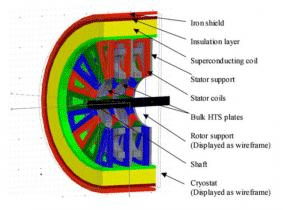With combustion-driven aircraft currently producing around 5% of greenhouse gas emissions, the time has clearly come to look at alternative power sources across the skyways. Electric motors have come a long way in relation to cars, but American scientists have now unveiled research that would enable high-powered, ultra-reliable electromagnetic engines to be built for airplanes. Using lightweight superconductors and emission-free hydrogen fuel cells to get around the problems experienced by previous attempts, these electric planes would be eco-friendly, exceptionally quiet and highly energy efficient as well as dramatically cutting down on maintenance costs through the elimination of engine hydraulics. This is an exciting convergence of technology with amazing implications throughout the transport sector.
Most current commercial aircraft use turbofans or turboprops to generate forwards thrust. Current systems based on gas turbines have proven very reliable but operate at low efficiency and produce large amounts of greenhouse gas emissions - a single long-haul flight pumps the equivalent of a tonne of carbon dioxide per passenger into the atmosphere. Furthermore, hydraulic actuators are very heavy and maintenance-intensive; they're the cause of around 70% of maintenance faults in airplanes. Thus the existing technology is clearly a compromise.
Earlier attempts at fitting planes with electric engines were thwarted by the size and weight of the magnets required to produce a sufficiently strong magnetic field, but new research published recently in the Institute of Physics Journal, Superconductor Science and Technology, postulates that the use of superconductors with hydrogen-based power plants can produce commercially feasible electric airplane propulsion systems.
Philippe Masson and Cesar Luongo from Florida State University, who have collaborated with Gerald Brown at NASA and Danielle Soban at Georgia Institute of Technology, explain that because superconductors lose no energy through electrical resistance, they could be very efficient components for a new type of aircraft propulsion.
The researchers explain that to build an electric aircraft will require propulsion motors that are high power, lightweight and compact. Current technology cannot meet these demands because an electric motor using conventional magnets can weigh up to five times as much as conventional jet engine and not be as fuel efficient.
In contrast, a superconducting motor would be very lightweight and far more efficient electrically, generating three times the torque of a conventional electric motor for the same energy input and weight. In addition, an electric aircraft would be far quieter than a conventional jet as there are no internal combustion processes involved.
However, superconducting magnets not only have to be cold, but require a unique energy supply. Masson and his colleagues believe they could solve both problems by using liquid hydrogen to run an electric fuel cell. Liquid hydrogen is cold enough to make the superconducting magnets work but also has four times as much energy weight for weight than aviation fuel.

